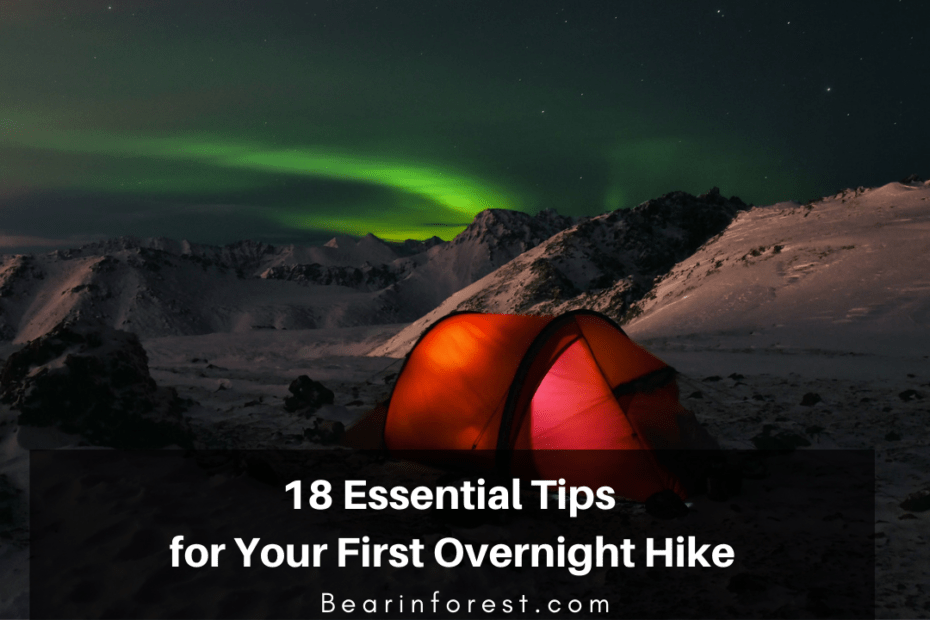There’s simply no denying the appeal of hitting the trail for an overnight hike. Backpacking requires going off the beaten path (quite literally) and setting up camp in the middle of the wilderness. This means a lot more planning and forethought than your standard day hike. But the reward is bountiful in the form of unspoiled views and the sweet serenity of the calm, quiet woods. Preparing for an overnight hike is a careful dance of packing only what you need while making sure all your bases are covered. Here are some simple tips for how to do that.

1. Understand the importance of layering. Layering up is crucial to your success in any long-haul hike because you’ll presumably be trekking through various temperatures and weather systems over the span of your journey.
2. Layer in a thin, warm and breathable material such as merino wool to help thermoregulate and mitigate moisture without adding bulk. Merino wool is also naturally odor-resistant and antimicrobial, which can help keep you feeling fresh even after days without a proper shower.
3. Wear a waterproof shell as your top layer, preferably one that’s packable so it doesn’t take up much room in your bag.
4. Make sure all your gear is water-resistant. The beauty of Mother Nature is that you just never know when an unexpected downpour might happen. Water-resistant gear will help keep you warm and dry in the event of unexpected precipitation, traversing through streams and cooling off in waterfalls.
5. Pack two pairs of socks. A backup pair of socks is crucial if you get your feet wet. We always recommend merino wool socks here as well because they are quick-drying and don’t take up a ton of room in your pack.
6. Go ultralight. We know that not everyone can trade up their sturdy standbys for (often expensive) ultralight gear, nor is that always sustainable. But investing in an ultralight backpack or sleeping bag can help save weight so you have more energy and can pack more of the essentials.
7. Pack a first-aid kit. Whatever you do, don’t embark on an overnight outdoors trip without a compact first-aid kit, complete with the basics.

8. Pack water filtering solutions. While you should definitely bring fresh water with you, make sure your emergency kit contains some water treatment tablets or a filtration device.
9. Tell someone where you’re going. If you’re heading off the grid, the last thing you should do before leaving home is let someone know where you’re going and how long you plan to be gone. Get specific about your location and timeframe so that someone knows where to find you in an emergency.
10. Bring a headlamp. When you’re hiking through the day and camping at night, you’ll learn quickly not to take light for granted! A headlamp is a saving grace because you can wear it while you set up camp and gather firewood if the sun has already begun to set. Make sure to bring a set of backup batteries, too.
11. Break in your hiking boots long before you set off. Never set off on any hike — let alone an overnight one — without breaking in the shoes you plan to wear. Break in your boots by walking around the house or neighborhood first to avoid blisters and pain points on the feet.
12. Pack lightweight sustenance. You need to pack plenty of sustenance when you’re burning calories in the wilderness. Make sure to pack items that are dense in nutrients but don’t take up a ton of space, such as freeze-dried meals, instant oatmeal, nuts, beef jerky, granola and more.
13. Wear your water. Having plenty of water is a requisite for a successful hiking trip, but it’s one of the things that weighs you down the most. These days, there are plenty of smart solutions for how to wear your water so you can free up space in your bag, such as with hydration chest packs.
14. Don’t forget your multitool. The multitool was literally designed for scenarios like this! It combines all kinds of basic essentials — a knife, scissors, pliers, a can opener, etc. — into a single lightweight tool you can slip in your pocket.

15. Know your way. Wayfinding is part of the fun when you’re in the backcountry and there isn’t a clear path or signs to follow. Make sure you pack the basics, including a paper map of the area and a compass.
16. Download your maps. You already know that the best backpacking spots have no cell service, so don’t count on being able to use your phone. However, you should still pack it for emergency purposes. Consider downloading maps (and any other media you may want to bring with you, such as music or podcasts) onto your phone so you can access them in remote areas.
17. Pack a solar charger. What good is your phone if you can’t plug it in? Luckily, they make some pretty nifty solar phone chargers that let you use the rays of the sun to keep your devices powered up.
18. Invest in a rain cover for your backpack. We’ve already discussed packing rain covers for yourself — indeed, that’s essential — but make sure you’re set up to protect your gear, too. A waterproof backpack cover is a great way to keep your gear dry and protected against the elements.
Perhaps more than any other outdoor adventure, backpacking requires significant planning and forethought. The good news is that if you think through many of the variables before you set off on your journey, you’ll be set up for success so you can enjoy every single step along the way.
